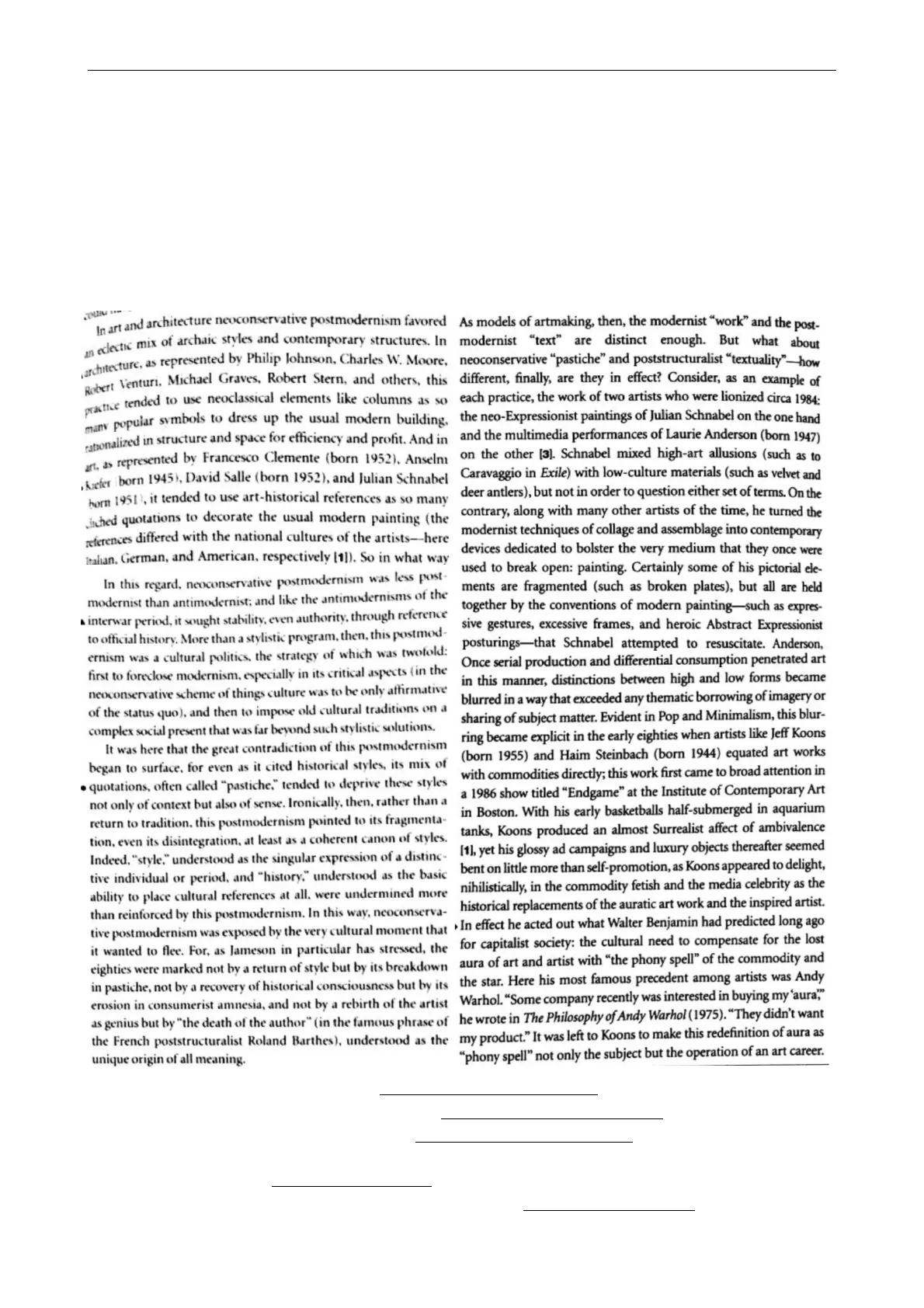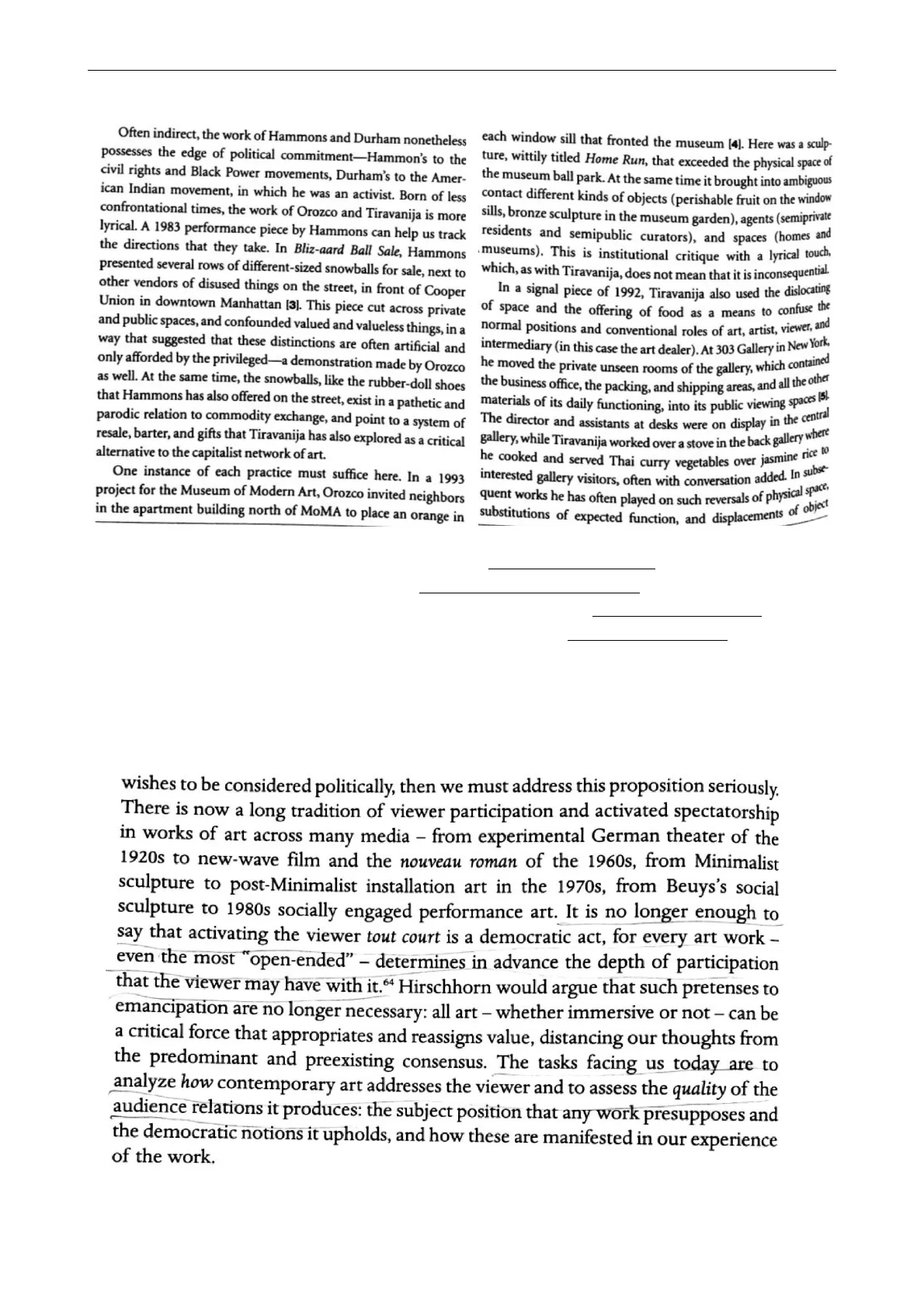Lezioni di Storia dell'Arte Contemporanea: Postmoderno e Post-colonialismo
Documento dall'Università sull'arte contemporanea, focalizzato su Postmoderno, Post-colonialismo e nuove generazioni di artisti. Il Pdf, utile per lo studio autonomo di Arte a livello universitario, analizza reazioni e movimenti artistici, l'emergere di nuove generazioni e strategie di appropriazione, con riferimenti a opere e artisti specifici.
Mostra di più8 pagine


Visualizza gratis il Pdf completo
Registrati per accedere all’intero documento e trasformarlo con l’AI.
Anteprima
Appunti di Storia dell'Arte Contemporanea
LEZIONI STORIA DELL'ARTE CONTEMPORANEA
MODULO II (M-Z)
LEZIONE 15/15
Postmoderno: Ritorno, Recupero e Trasformazione di Schemi
Reazioni e Reazionari negli Anni Ottanta
Postmoderno come ritorno/recupero/trasformazione di vecchi schemi
In art and architecture neoconservative postmodernism favored As models of artmaking, then, the modernist "work" and the post-
an eclectic mix of archaic styles and contemporary structures. In modernist "text" are distinct enough. But what about
architecture, as represented by Philip Johnson, Charles W. Moore, neoconservative "pastiche" and poststructuralist "textuality"-how
Robert Venturi, Michael Graves, Robert Stern, and others, this
practice tended to use neoclassical elements like columns as so
many popular symbols to dress up the usual modern building,
rationalized in structure and space for efficiency and profit. And in
art, as represented by Francesco Clemente (born 1952), Anselm
Kiefer born 1945), David Salle (born 1952), and Julian Schnabel
born 1951), it tended to use art-historical references as so many
Jiched quotations to decorate the usual modern painting (the
references differed with the national cultures of the artists-here
Italian, German, and American, respectively [1]). So in what way
In this regard, neoconservative postmodernism was less post-
modernist than antimodernist; and like the antimodernisms of the
interwar period, it sought stability, even authority, through reference
to official history. More than a stylistic program, then, this postmod-
ernism was a cultural politics, the strategy of which was twofold:
first to foreclose modernism, especially in its critical aspects (in the
neoconservative scheme of things culture was to be only affirmative
of the status quo), and then to impose old cultural traditions on a
complex social present that was far beyond such stylistic solutions.
Pastiche e Testualità nel Postmodernismo
different, finally, are they in effect? Consider, as an example of
each practice, the work of two artists who were lionized circa 1984:
the neo-Expressionist paintings of Julian Schnabel on the one hand
and the multimedia performances of Laurie Anderson (born 1947)
on the other [3]. Schnabel mixed high-art allusions (such as to
Caravaggio in Exile) with low-culture materials (such as velvet and
deer antlers), but not in order to question either set of terms. On the
contrary, along with many other artists of the time, he turned the
modernist techniques of collage and assemblage into contemporary
devices dedicated to bolster the very medium that they once were
used to break open: painting. Certainly some of his pictorial ele-
ments are fragmented (such as broken plates), but all are held
together by the conventions of modern painting-such as expres-
sive gestures, excessive frames, and heroic Abstract Expressionist
posturings-that Schnabel attempted to resuscitate. Anderson,
Once serial production and differential consumption penetrated art
in this manner, distinctions between high and low forms became
blurred in a way that exceeded any thematic borrowing of imagery or
sharing of subject matter. Evident in Pop and Minimalism, this blur-
ring became explicit in the early eighties when artists like Jeff Koons
(born 1955) and Haim Steinbach (born 1944) equated art works
with commodities directly; this work first came to broad attention in
a 1986 show titled "Endgame" at the Institute of Contemporary Art
in Boston. With his early basketballs half-submerged in aquarium
tanks, Koons produced an almost Surrealist affect of ambivalence
[1], yet his glossy ad campaigns and luxury objects thereafter seemed
bent on little more than self-promotion, as Koons appeared to delight,
nihilistically, in the commodity fetish and the media celebrity as the
historical replacements of the auratic art work and the inspired artist.
It was here that the great contradiction of this postmodernism
began to surface, for even as it cited historical styles, its mix of
. quotations, often called "pastiche," tended to deprive these styles
not only of context but also of sense. Ironically, then, rather than a
return to tradition, this postmodernism pointed to its fragmenta-
tion, even its disintegration, at least as a coherent canon of styles.
Indeed, "style," understood as the singular expression of a distinc-
tive individual or period, and "history," understood as the basic
ability to place cultural references at all, were undermined more
than reinforced by this postmodernism. In this way, neoconserva-
tive postmodernism was exposed by the very cultural moment that . In effect he acted out what Walter Benjamin had predicted long ago
it wanted to flee. For, as Jameson in particular has stressed, the
for capitalist society: the cultural need to compensate for the lost
aura of art and artist with "the phony spell" of the commodity and
the star. Here his most famous precedent among artists was Andy
Warhol. "Some company recently was interested in buying my'aura"
eighties were marked not by a return of style but by its breakdown
in pastiche, not by a recovery of historical consciousness but by its
erosion in consumerist amnesia, and not by a rebirth of the artist
as genius but by "the death of the author" (in the famous phrase of he wrote in The Philosophy of Andy Warhol (1975). "They didn't want
the French poststructuralist Roland Barthes), understood as the my product." It was left to Koons to make this redefinition of aura as
unique origin of all meaning.
Opere e Artisti del Postmodernismo
- Julian Schnabel: "Exile" (1980); https://tinyurl.com/y4w9jovq
- Francesco Clemente: "Waiting" (1982); https://tinyurl.com/y29y8k9w
- Sandro Chia: "Hands Game" (1981); https://tinyurl.com/y635g57t
- Jeff Koons: "Two Ball Total Equilibrium Tank (Spalding Dr. J Silver Series, Wilson
Aggresor)" (1985); https://bit.ly/3cRq5vl - Jeff Koons: "New Hoover Convertibles" (1986-87); https://bit.ly/2ZoLOH2
Prof. Dr.phil. Diego Mantoan
Lezione 15/15 - p.1/8
Post-Colonialismo e (Ab)Origini tra Anni Ottanta e Novanta
Appunti di Storia dell'Arte Contemporanea
Often indirect, the work of Hammons and Durham nonetheless
possesses the edge of political commitment-Hammon's to the
civil rights and Black Power movements, Durham's to the Amer-
ican Indian movement, in which he was an activist. Born of less
confrontational times, the work of Orozco and Tiravanija is more
lyrical. A 1983 performance piece by Hammons can help us track
the directions that they take. In Bliz-aard Ball Sale, Hammons
presented several rows of different-sized snowballs for sale, next to
other vendors of disused things on the street, in front of Cooper
Union in downtown Manhattan [3]. This piece cut across private
and public spaces, and confounded valued and valueless things, in a
way that suggested that these distinctions are often artificial and
only afforded by the privileged-a demonstration made by Orozco
as well. At the same time, the snowballs, like the rubber-doll shoes
that Hammons has also offered on the street, exist in a pathetic and
parodic relation to commodity exchange, and point to a system of
resale, barter, and gifts that Tiravanija has also explored as a critical
alternative to the capitalist network of art.
One instance of each practice must suffice here. In a 1993
project for the Museum of Modern Art, Orozco invited neighbors
in the apartment building north of MoMA to place an orange in
each window sill that fronted the museum [4]. Here was a sculp-
ture, wittily titled Home Run, that exceeded the physical space of
the museum ball park. At the same time it brought into ambiguous
contact different kinds of objects (perishable fruit on the window
sills, bronze sculpture in the museum garden), agents (semiprivate
residents and semipublic curators), and spaces (homes and
museums). This is institutional critique with a lyrical touch,
which, as with Tiravanija, does not mean that it is inconsequential.
In a signal piece of 1992, Tiravanija also used the dislocating
of space and the offering of food as a means to confuse the
normal positions and conventional roles of art, artist, viewer, and
intermediary (in this case the art dealer). At 303 Gallery in New York,
he moved the private unseen rooms of the gallery, which contained
the business office, the packing, and shipping areas, and all the other
materials of its daily functioning, into its public viewing spaces [5].
The director and assistants at desks were on display in the central
gallery, while Tiravanija worked over a stove in the back gallery where
he cooked and served Thai curry vegetables over jasmine rice to
interested gallery visitors, often with conversation added. In subse-
quent works he has often played on such reversals of physical space,
substitutions of expected function, and displacements of object
Opere e Artisti del Post-Colonialismo
- David Hammons: "Bliz-aard Ball Sale" (1983); https://bit.ly/3e601Lo
- Gabriel Orozco: "Home Run" (1993); https://tinyurl.com/yxb69d37
- Rirkrit Tiravanija: "Untitled (303 Gallery, New York)" (1992); https://bit.ly/36fOvMK
- Liam Gillick: "Big Conference Platform Platform" (1998); https://bit.ly/36jFKKT
Claire Bishop e l'Estetica Relazionale
Claire Bishop (1971-)
Antagonism and Relational Aesthetics (October, 110, 2004)
wishes to be considered politically, then we must address this proposition seriously.
There is now a long tradition of viewer participation and activated spectatorship
in works of art across many media - from experimental German theater of the
1920s to new-wave film and the nouveau roman of the 1960s, from Minimalist
sculpture to post-Minimalist installation art in the 1970s, from Beuys's social
sculpture to 1980s socially engaged performance art. It is no longer enough to
say that activating the viewer tout court is a democratic act, for every art work -
even the most "open-ended" - determines in advance the depth of participation
that the viewer may have with it.64 Hirschhorn would argue that such pretenses to
emancipation are no longer necessary: all art - whether immersive or not - can be
a critical force that appropriates and reassigns value, distancing our thoughts from
the predominant and preexisting consensus. The tasks facing us today are to
analyze how contemporary art addresses the viewer and to assess the quality of the
audience relations it produces: the subject position that any work presupposes and
the democratic notions it upholds, and how these are manifested in our experience
of the work.
Prof. Dr.phil. Diego Mantoan
Lezione 15/15 - p.2/8